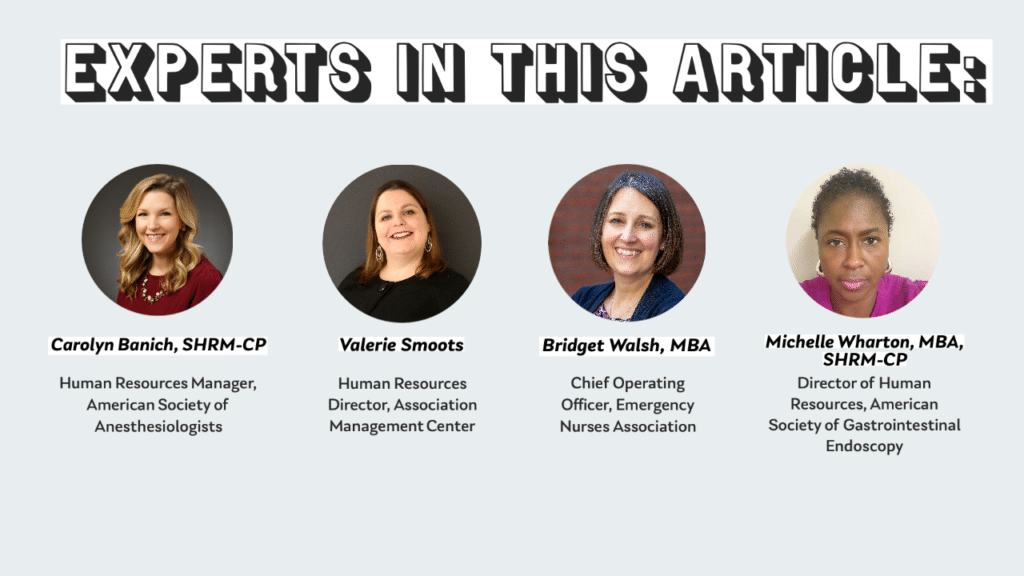Association HR Policies: What’s Changed? What’s Next?

While the past two years have been stressful and challenging for everyone, they have been particularly difficult for human resources professionals. Not only have HR departments had to shift policies on the fly and adapt entire teams to a new reality, but they’ve had to implement these changes virtually and in an environment that seems to be changing daily. While business for the association community continued in the wake of COVID-19, many policies had to change. As we look back, how did these changes impact the association workforce? What’s on the horizon in terms of additional policies or areas of focus to enhance employee wellness and increase workplace flexibility?
To help discuss these topics and others, FORUM interviewed four HR policy leaders in the association community:
FORUM: The pandemic has dramatically changed our work environment and policies, especially as it relates to the health and well being of our staff. What have been some of the most significant policy changes at your organization in the last 18 months?
Banich: As an organization, we had to react quickly to ensure the safety and wellbeing of our staff. We transitioned to a fully remote workforce overnight, creating a remote work policy that provided guidance and expectations to help staff navigate their new normal. We also assessed which other benefits we could add, such as a home office and technology allowance policy and stipend, that would support our employees in their new work environment.
Smoots: Association Management Center implemented quite a few new policy and practice changes that focused in on our staff’s well being and provided more flexibility. Some examples include increasing PTO (personal time off) accruals, adding additional holidays (floating and Juneteenth), increasing our paid leave benefit, implementing summer hours, and partnering with our EAP (employee assistance program) to offer quarterly wellness webinars.
Wharton: Some of the most significant policy changes and practices that we’ve implemented have been:
- Uniform remote work standards to ensure high-quality partnerships and work as it related to our members, stakeholders and colleagues.
- Office safety protocols: We are currently in a voluntary return-to-office status but plan to return to the office early next year. We have implemented COVID-related safety and reporting protocols to mitigate risk and ensure the safety of our team members and guests when they visit our facility.
- We also implemented “Wellness Wednesdays,” with a focus on our team’s mental and physical well being. We partnered with yoga instructors to provide virtual yoga sessions for our team. We also partnered with our EAP to provide virtual mental wellness sessions to learn how to cope with “pandemic-specific stressors.”
- Additionally, we wanted to ensure that our team continued to interact (mostly virtually) and have “fun” during this stressful pandemic climate. We hosted several team-building oriented activities, such as virtual scavenger hunts, trivia, holiday recipe sharing and decorating contest and sports themed contests around events like the Super Bowl and March Madness.
Walsh: We have done many of the same pandemic-related engagements and support items shared in this thread. Our initial focus was on the quick switch to fully remote – focusing on tools and resources to keep our teams engaged, connected and able to support our members on the front line. As we moved through the pandemic we focused on two avenues of policy and program focus – our health and safety protocols related to COVID and the evolution of our work environment.
In July 2021 we implemented our “Transition to Hybrid” plan, which focused on a fundamental shift to a hybrid working model allowing all staff the opportunity to work a blended schedule of remote and onsite. Our baseline is three days remote and two days in the office, built on flexibility and the value of team collaboration as program fundamentals. We removed any restrictions or qualifications to working remotely, expecting teams to manage performance accordingly and support flexibility and manage scheduling at the team level. We have also worked to ensure our systems support this approach, improving technology capabilities in meeting rooms, providing headsets, etc. We also provided all staff and leaders a multi-session workshop aimed at successfully leading and working in a hybrid work environment.
Additionally, we looked at our benefit programs and how we could continue to support our staff’s wellness and mental health needs. We supplemented our EAP with a new program, Boon Health, focused on mental health and workplace coaching.
FORUM: Your organizations have focused on wellness and mental health as a component of this shifting work environment and how we’re trying to deal with the pandemic overall. How have your staff teams responded to these new offerings and programs? Do you see more opportunities to focus on mental health in the future?
Banich: ASA has always been a strong advocate for mental and physical health and well being, ensuring there were plenty of support resources readily available. With the rapid development of the pandemic, we wanted to make sure that additional resources were given to staff, to deepen our commitment to wellness and sustain employees during that difficult time. We partnered closely with our EAP, to provide additional counseling, weekly well-being communication, live wellness sessions focused on resiliency, burnout, and stress, and morale-boosting activities. Our employees’ participation in wellness events increased greatly and allowed our staff to stay connected in such a disconnected time. We also conducted several pulse-check surveys to assess employees wants and needs and received great feedback and gratitude on the additional offering of wellness activities.
Seeing the impact of these wellness offerings, along with no end in sight for the pandemic, we enforced a mandatory company-wide week off, to focus on mental health. This allowed staff to have uninterrupted time off, to focus on themselves, and come back recharged and rejuvenated! We hope to continue many of these same efforts as we start to plan our wellness strategy for 2022.
Walsh: Similar to ASA, ENA has always been committed to the health and well being of our team. The rapidly changing environment with the pandemic required us to shift from many of our onsite activities (Run Club, Walking Wednesday, etc.) to more virtual events, including yoga, coffee breaks and a more targeted investment in mental health coaching. That new program has been very well received by those that have participated and we’ve committed to greater awareness building and are partnering with managers to make targeted recommendations when appropriate.
Our HR team is currently planning our updated wellness and recognition strategy for 2022, focused on alignment with our hybrid work environment. We see this as an important commitment moving forward. We’ve also instituted some small measures to try and address “Zoom fatigue” and the challenges of back-to-back meetings, such as building five-minute passing periods as a default in our Outlook calendar system.
We have conducted many on-site and virtual wellness activities such as chair yoga, lunchtime walking groups, meditation and mindfulness sessions and impromptu dance breaks. We make an effort to keep the activities fun and interactive as much as possible.
Wharton: At ASGE we recognize that our employees are our most valuable assets and ensuring that they have the resources to be healthy, both mentally and physically, oftentimes has a direct correlation to quality work performance, increased morale and employee engagement. We have conducted many on-site and virtual wellness activities such as chair yoga, lunchtime walking groups, meditation and mindfulness sessions and impromptu dance breaks. We make an effort to keep the activities fun and interactive as much as possible.
We also partner with our EAP provider to provide support in the areas of coping with pandemic “fatigue,” stress and anxiety. These programs have been well-attended and received and we plan to continue this partnership and offer more mental health-themed sessions to our team.
We also participate in annual community service projects that “feed the soul,” which have included food and clothing drives. We are doing a virtual food drive this year.
It is important to us that our employees know that we care about their overall well being. We will continue our current wellness activities and plan to enhance our offerings in the future. We’ll continue to make resources available to our team both in-person and via virtual platforms as well.
Smoots: The pandemic allowed so many to take a necessary pause and take count of what is important. Work-life balance took on a new meaning and because of this I feel that our staff embraced the benefit changes we made. We also saw a strong desire for HR to share resources on productivity/wellness-related topics. Our quarterly wellness webinars were optional to attend and yet, we saw very high attendance numbers compared to other non-wellness webinar offerings. We also saw an uptick in usage of our employee assistance program compared to previous years. To continue this momentum, we will continue to highlight various resources around mental health, resiliency, mindfulness and other wellness-related topics. Another approach that has seemed to work well is allowing space for staff to share with their peers resources that have worked from them via intranet posts, team calls, or during all company meetings.
FORUM: So many of these policy changes were necessary to adjust to the pandemic, but as you look back, what has been the most impactful and positive policy outcome you’ve seen in the last 18 months? Looking ahead, what do see as the next big challenge or issue to address?
Wharton: The most impactful policy, or should I say, practice for us has been exhibiting the capability to continue to deliver high-quality programs and initiatives (virtually) to our members by being agile, fluid and innovative in some of the most challenging of times. Our team “leveled up” and rose to the occasion and we take great pride in that.
Looking ahead, our next hurdle will be to return the team to the office environment safely while continuing to excel at providing the same quality products and programs to our members in a now hybrid environment. I am wholly confident that we will be successful in doing so.
Smoots: This question is so timely for our organization as Association Management Center just released an updated version of our employee handbook that better defines our hybrid work policies/practices as we head into 2022. With input from staff and our management team over the last 18 months, we arrived at a new “Hybrid Work Environment” policy. This policy defines how we will operate in a true hybrid environment with most staff coming into the office one to two days per week, allowing for greater flexibility/consideration for employees who are moving out of state, and created pathways for employees to request remote work flexibility on both a short-term and long-term basis. As we move forward, I believe one of the biggest challenges will be putting these new hybrid practices in motion and establishing new “norms” that will inevitably evolve both on a team- and company-wide level.
I think the most important change is realizing that following the immediate shifts and impact of the pandemic, there is no “going back” or “returning to the way it was.”
Walsh: I would echo Valerie’s response here. I think the most important change is realizing that following the immediate shifts and impact of the pandemic, there is no “going back” or “returning to the way it was.” We are all different, the world is different and we’ve all learned new ways of engaging, working and managing our lives. As employers, it is important we recognize that opening for our teams and within our policies. At ENA we have moved to a hybrid model – minimum of two days on-site for all staff. Remote working isn’t something you have to apply to do, doesn’t require a waiting period, and you don’t have to “prove” you are good at it. Rather, it is an expectation for all.
Exemplifying our culture, ENA’s hybrid workplace policy is built upon the value of in-person connection and collaboration, while embracing flexibility and empowering staff and managers to work together to build work schedules that support individual and team needs. ENA’s definition of a flexible, hybrid workplace includes the ability for all staff to work both on-site and from home. The hybrid workplace policy eliminates the need for waiting periods and rigorous application processes previously used to grant work-from-home days. The hybrid approach includes technology that supports engagement and collaboration regardless of work location.
Staff schedules are built upon core hours (9:30 a.m. – 3:30 p.m.) with the flexibility to manage start and end times to meet team and individual needs. All staff can work from home two days a week on a regular basis. The ability to adapt and change on-site and remote workdays on occasion will be managed at the team level, accomplished through active partnership and shared flexibility.
Fundamental to moving forward will be flexibility within policies, educating managers and leaders and clearly communicating with teams and people.
Tags
Related Articles
Rewirement: A New Approach to Retirement
Retirement doesn’t have to mean stepping away—it can be a thrilling "rewirement" into a purpose-driven,...
Career Corner Roundup
Every single Career Corner article we published in 2024!
Driving Impact through a Portfolio Analysis
Conducting regular portfolio analyses helps associations streamline their programs, align with strategic goals, and optimize...







